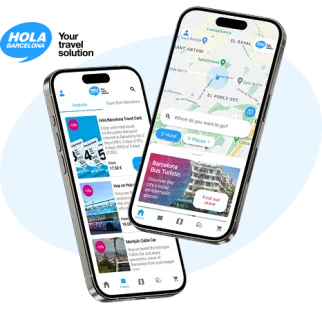Palau del Baró de Quadras
A Modernista mansion with two facades and two styles
Avinguda Diagonal is home to a Gothic-inspired building that has a facade on Carrer del Rosselló decorated in the Modernista style. The house owned by the Baron of Quadras had its main entrance on Carrer del Rosselló, but the growing importance of Avinguda Diagonal led the architect responsible for its renovation, Puig i Cadafalch, to orient it to this elegant new avenue.

Barcelona Bus Turístic, on the Hola Barcelona app
Your app for visiting the city with the Barcelona Bus Turístic: routes, stops and the most iconic places. A comfortable way to carry your tickets too!
Why visit Palau del Baró de Quadras?
In the late 19th century, the industrialist Josep Quadras i Prim bought a small apartment block on Carrer del Rosselló whose small garden gave onto Avinguda Diagonal. His son, Manual Quadras i Feliu, the first Baron de Quadras, inherited the house and in 1902 he commissioned Puig i Cadafalch to renovate it.
The architect decided to change the building’s entrance from its original site on Carrer del Rosselló to Avinguda Diagonal. This was a significant change at a time when Avinguda Diagonal was starting to consolidate its importance within the layout of the new Barcelona. Puig i Cadafalch removed the garden and in accordance with his usual practice he equipped the house with a facade inspired by the Northern European Gothic style, while the entrance on Carrer del Rosselló conserved the Modernista style of the old building, adding Vienna Secession elements.
In addition to its architecture, another outstanding feature of the palace is its profuse decoration, which combines neo-Gothic elements, such as the wrought iron door and the grand staircase, with neo-Arabesque influences present in details like its mosaics, sgraffito works and painted wood. The sculptors Eusebi Arnau and Alfons Juyol i Bach collaborated on the ornamentation of the house, which was declared a Catalan Cultural Asset of National Interest in 1976, and Manuel Ballarín collaborated on the ironwork, Lluís Bru on the Roman mosaic and Mario Maragliano on the ceramic pieces.
How do you get to Palau del Baró de Quadras?
Hop off at the Passeig de Gràcia – La Pedrera stop on the Red Route or the Blue Route of Barcelona Bus Turístic and then walk to Avinguda Diagonal and the Palau del Baró de Quadras is between Passeig de Gràcia and Carrer de Pau Claris.
For the most curious of you
- Did you know? The palace has been used for a variety of purposes throughout its history: it was previously home to the Music Museum of Barcelona and then to the Casa Àsia cultural centre and now it is the headquarters of the Ramon Llull Institute, which promotes Catalan language and culture.
- Local’s tip: Puig i Cadafalch’s architectural legacy is extensive and highly diverse. The particularly admirable buildings he designed in his Modernista period are Casa Amatller and Casa de les Punxes, which is very close to the Palau del Baró de Quadras. Mention should also be made of Casa Comalat, designed by the architect Salvador Valeri i Pupurull, which is opposite the Palau del Baró de Quadras, on Avinguda Diagonal, given that its singular galleries can be seen from the rear of the building, on the corner of Carrer de Còrsega and Carrer de Pau Claris.
- A must: To see how Puig i Cadafalch’s style progressed, following the itinerary Casa Amatller – Palau del Baró de Quadras – Casa de les Punxes.














